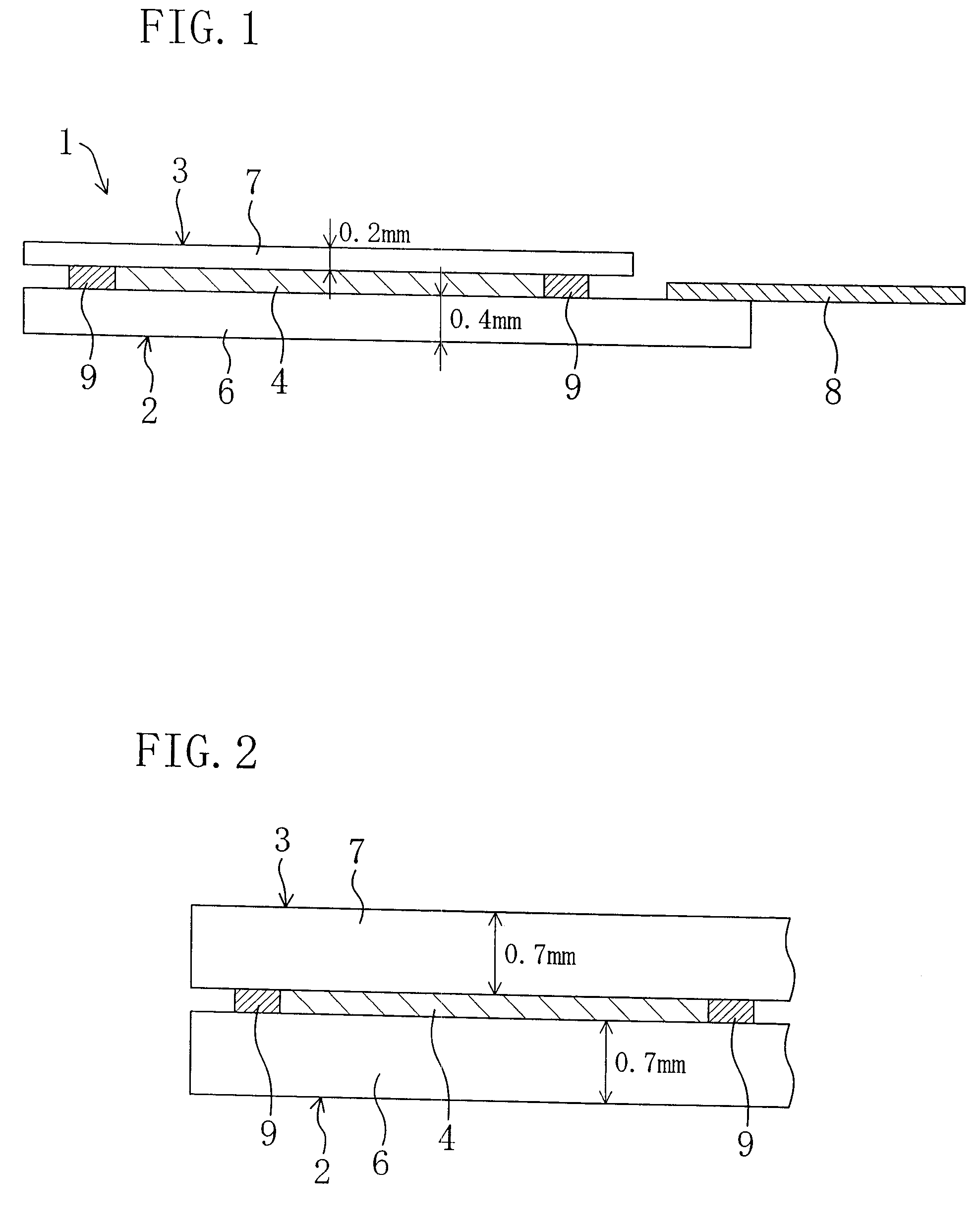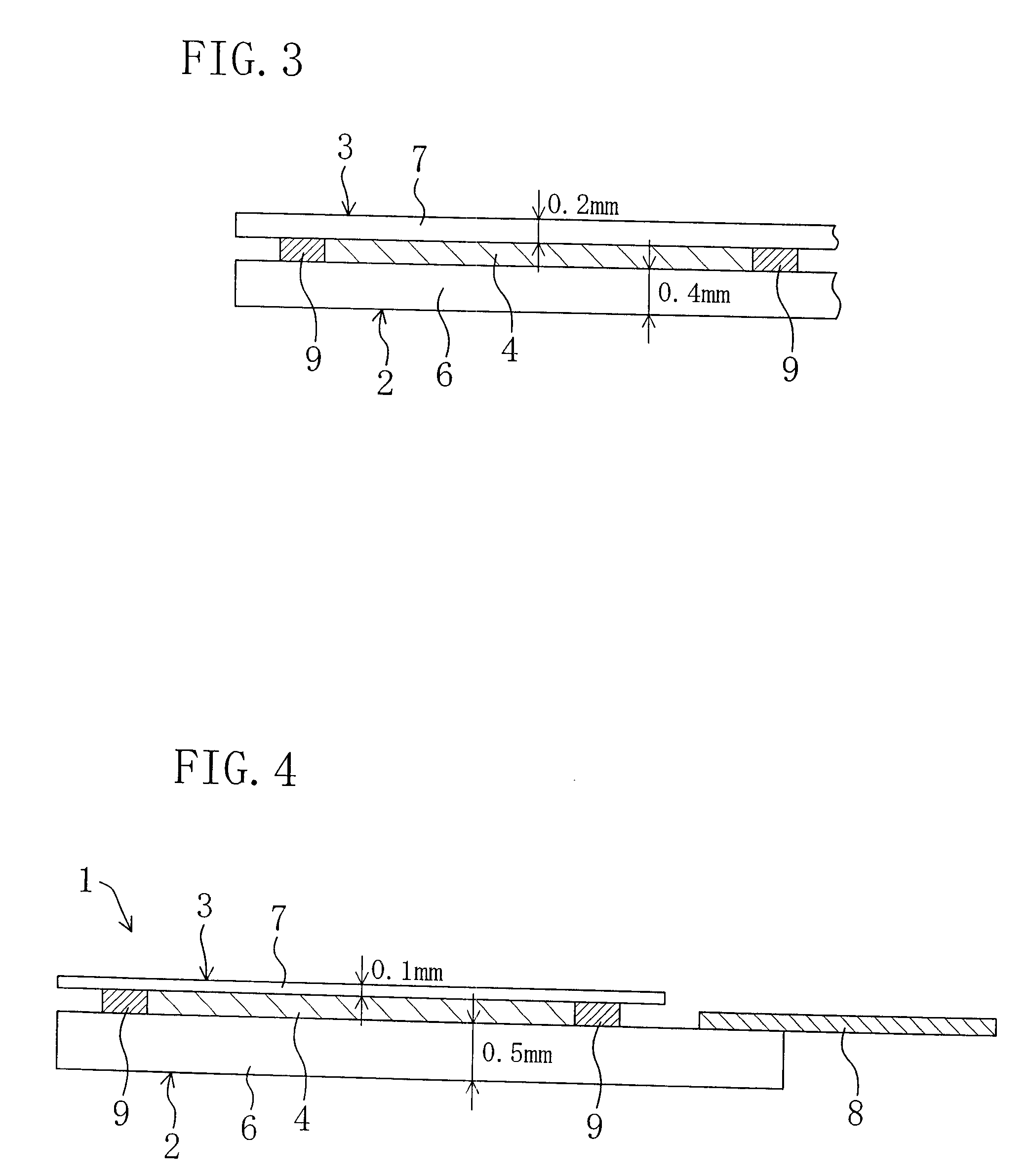Display device and method for manufacturing the same
a technology of display device and liquid crystal display panel, which is applied in the direction of lamination ancillary operations, instruments, chemistry apparatus and processes, etc., can solve the problems of reducing the size of the device, affecting the reliability of the liquid crystal display device, and reducing the thickness of the two substrates. , to achieve the effect of reducing the thickness of the two substrates
- Summary
- Abstract
- Description
- Claims
- Application Information
AI Technical Summary
Benefits of technology
Problems solved by technology
Method used
Image
Examples
first embodiment
[0052]FIGS. 1 to 5 show a first embodiment of the present invention.
[0053]FIG. 1 is a sectional view schematically illustrating a liquid crystal display device 1 as a display device of the present invention. As shown in FIG. 1, the liquid crystal display device 1 includes an active matrix substrate 2 as a first substrate, a counter substrate 3 as a second substrate facing the active matrix substrate 2 and a liquid crystal layer 4 as a display medium layer provided between the substrates 2 and 3.
[0054]The active matrix substrate 2 includes a glass substrate 6 and a plurality of thin film transistors (not shown and abbreviated as TFTs) which are formed on the surface of the glass substrate 6 facing the liquid crystal layer 4. The active matrix substrate 2 further includes a plurality of pixels arranged in a matrix. The TFTs are provided on a pixel-by-pixel basis.
[0055]The thickness of the glass substrate 6 is 0.4 mm, for example. An orientation film (not shown) is formed on the surfac...
example
[0071]Now, an explanation of a specific example of the present invention will be provided.
[0072]A glass substrate A (AN100 manufactured by ASAHI GLASS) was used as the glass substrate 6 of the active matrix substrate 2 and a glass substrate B (1737 manufactured by Corning) was used as the glass substrate 7 of the counter substrate 3. Under certain etching conditions, the etch rate of the glass substrate A is 4.4 μm / min and that of the glass substrate B is 5.2 μm / min.
[0073]Elements such as TFTs and wires were formed on the glass substrate A and a color filter and other elements were formed on the glass substrate B. Then, the glass substrates A and B are bonded together. The bonded substrates were immersed in an etching solution containing hydrogen fluoride under the above-described conditions to etch the substrates for about 42 minutes. As shown in Table 1, the thicknesses of the glass substrates A and B after the 42-minute etching were 0.52 mm and 0.48 mm, respectively.
TABLE 1Time (...
second embodiment
[0075]FIG. 6 shows a second embodiment of the present invention. In the following embodiments, the same components as those shown in FIGS. 1 to 4 are indicated by the same reference numerals to omit a detailed explanation.
[0076]A liquid crystal display device 1 of the present embodiment includes an active matrix substrate 2, a counter substrate 3 and a liquid crystal layer 4 as shown in FIG. 6. The active matrix substrate 2 includes a 0.5 mm thick glass substrate 6. The counter substrate 3 includes a 0.1 mm thick plastic substrate 10. In other words, the liquid crystal display device 1 includes the glass substrate 6 and the plastic substrate 10 which is provided to face the glass substrate 6 and thinner than the glass substrate 6.
[0077]In order to fabricate the liquid crystal display device 1 described above, first, in the step of bonding the substrates, a color filter (a coloring layer), TFTs, pixel electrodes, signal wires, scanning wires and a driver which are not shown in the dr...
PUM
| Property | Measurement | Unit |
|---|---|---|
| thicknesses | aaaaa | aaaaa |
| thicknesses | aaaaa | aaaaa |
| thicknesses | aaaaa | aaaaa |
Abstract
Description
Claims
Application Information
 Login to View More
Login to View More - R&D
- Intellectual Property
- Life Sciences
- Materials
- Tech Scout
- Unparalleled Data Quality
- Higher Quality Content
- 60% Fewer Hallucinations
Browse by: Latest US Patents, China's latest patents, Technical Efficacy Thesaurus, Application Domain, Technology Topic, Popular Technical Reports.
© 2025 PatSnap. All rights reserved.Legal|Privacy policy|Modern Slavery Act Transparency Statement|Sitemap|About US| Contact US: help@patsnap.com



